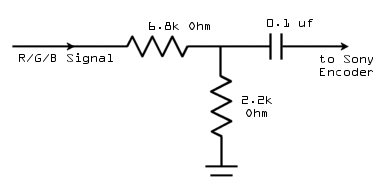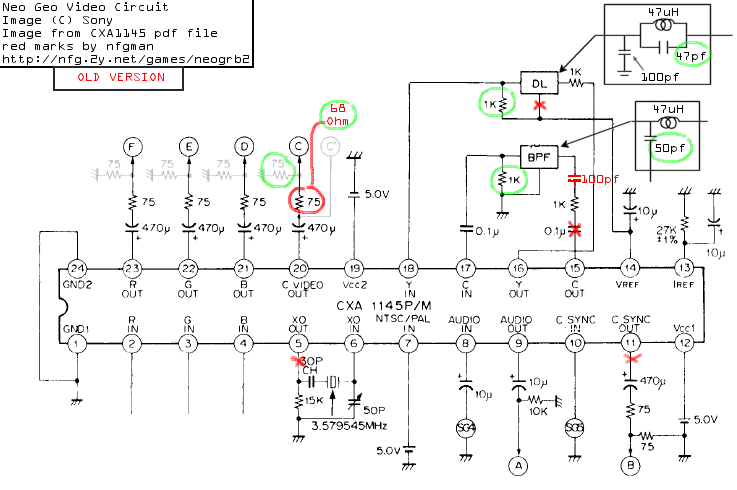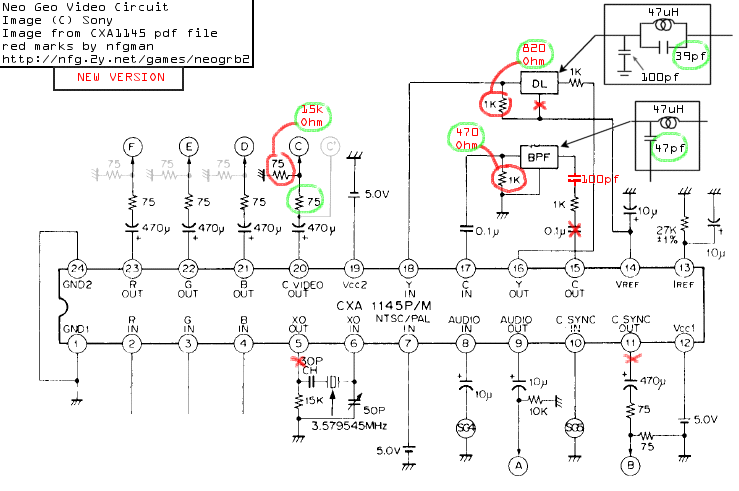| The Story |
As we saw in a a previous article, the Neo Geo home cartridge system went through several different revisions that affected different parts of the video output circuitry. Different aspects of the video output were changed, some for the better and some not. In this followup I want to look at exactly what changes were made to the Neo hardware that can account for these changes. This is a fairly technical article, and some of you might want to give up now, or maybe just try and brave the next paragraph.
First, a brief look at how the Neo Geo generates its video. Like most modern consoles an RGB signal is generated and fed to an encoder that creates the composite video signal we know so well. You remember composite video, that's the round yellow connector on your AV cables. Where the Neo differs is in the creation of these RGB signals. The video-RAM chip holding the image passes pure binary data to another chip called a flip-flop which holds the image steady. This chip then outputs the binary data through a series of resistors, each with a value approximately double that of the last, all of which are combined into one analogue signal of varying intensity (brightness). It sounds complicated but if you have even a passing idea of how binary works it's actually frighteningly simple. It's also an old technique - the old Atari 800 series of computers used the same system to generate its video. The signal output from this resistor array should be the proper RGB level to feed into the Sony video encoder chip.
|

Seven bits of data are converted into an analogue signal
You can see above how the seven binary bits are fed from chip to chip and finally output as one signal. The latching chip reads all the bits and holds them so there are no timing errors between bits. This circuit is repeated three times on the PCB, and each Red, Green and Blue signal goes through it. Up to and including this point all Neo Geo hardware is the same, every cartridge, CD + arcade board uses the same circuits for this. In the MVS units the signals output from this circuit are fed directly to the JAMMA connector. In the home systems they are modified a bit, fed through the Sony chip, then modified a bit more on the way out. Here's what the happens next on a serial number ~30,000 Neo Geo system:
|

The old values, pre-encoder
There were two components changed here. The capacitor was changed from a 0.1uf to a 1.0uf, and the resistor from a 2.2k Ohm to 3k Ohm. These component values were taken from the last model Neo system (~230,000):
|

New values, pre-encoder
The RGB signal after the Sony encoder is different on the two models as well. Here's the old model:
|

Old system post-encoder RGB output
For reasons unknown SNK's engineers moved away from Sony's default component values and went with a 100uf capacitor and 68 Ohm resistor. They switched back to Sony's recommended values on the later models:
|

New system post-encoder RGB output
These weren't the only changes made - much of the Sony encoder's support components were tinkered with as well. Here's an analysis of the differences between the two models. To remind, we are comparing only two different models here, the 30,000 series and the 250,000 series. There's a minor change around the 125,000 mark, but those differences are not checked.
|

Old system encoder circuit.
GREEN indicates differences between revisions.
RED indicates differences between SNK's implementation and Sony's recommended values.
|

New system encoder circuit.
What does it all mean? At this point I dunno. More input is needed. This is what was done. If you wanted the older, clearer (but darker) RGB you might consider replacing the newer components with the older values. If you prefer a brighter picture at the expense of a little striping (explained here) then your old system might appreciate the newer values.
|
|















